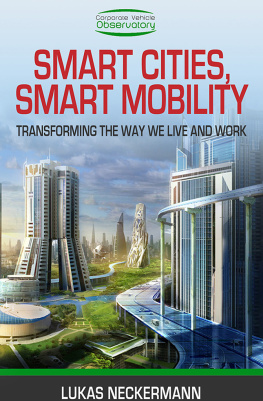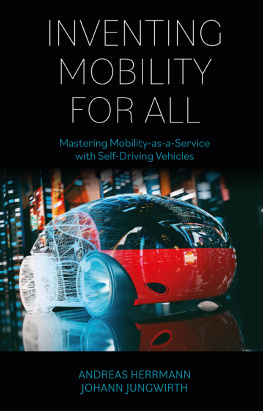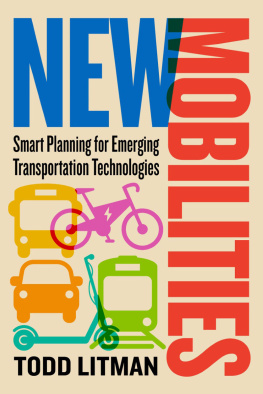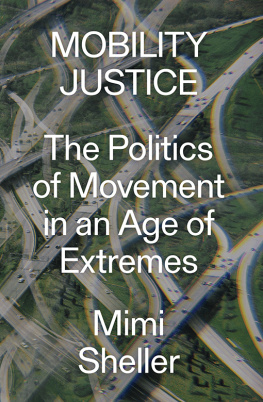

Copyright 2017 Lukas Neckermann.
The moral right of the author has been asserted.
Neckermann Strategic Advisors is a trading name of Neckermann Ltd.
"The Mobility Revolution" and "Corporate Mobility Breakthrough" are trademarks of Neckermann Ltd. registered in England and Wales (Company Number 08783735).
For more information, see www.neckermann.net
Apart from any fair dealing for the purposes of research or private study, or criticism or review, as permitted under the Copyright, Designs and Patents Act 1988, this publication may only be reproduced, stored or transmitted, in any form or by any means, with the prior permission in writing of the publishers, or in the case of reprographic reproduction in accordance with the terms of licences issued by the Copyright Licensing Agency. Enquiries concerning reproduction outside those terms should be sent to the publishers.
Matador
9 Priory Business Park
Kibworth Beauchamp
Leicestershire LE8 0RX, UK
Tel: 0116 279 2299
Email:
Web: www.troubador.co.uk/matador
ISBN 9781788030540
British Library Cataloguing in Publication Data.
A catalogue record for this book is available from the British Library.

Matador is an imprint of Troubador Publishing Ltd
To those who are creating a smarter future.
And to those who benefit from it: all of us.
Contents
Foreword
The Corporate Vehicle Observatory (CVO) is a neutral knowledge sharing platform dedicated to all corporate fleet stakeholders whether they are private or public companies, fleet owners, fleet lessors, car manufacturers or the media.
The CVO was founded in 2002 by BNP Paribas and its subsidiary Arval, itself specialized in the full service leasing of corporate fleets. It is present today in 15 countries across Europe, with a mission to inform and engage all the players of the industry in discussion about the developments of corporate mobility in its broadest sense.
Safety, alternative energies and fuel, social changes and technological developments are just some of the key industry trends that the CVO observes and analyses, at the local, national, and international levels.
After its collaboration in 2016 on Corporate Mobility Breakthrough 2020, the CVO and Lukas Neckermann chose to follow the journey onward, heading for smarter cities and smarter mobility. In this new release, Lukas analyzes the major changes that will occur around urban mobility, focusing on the specific interconnection between smart mobility and smart cities, and how this leads to a different, new, smart way of living, commuting, and working.
We hope this publication will give you the key to understanding this major transformation in our future living and working environments, and allow you to operate in a smooth and smart way.
Virginie Chassard
Corporate Vehicle Observatory
Introduction
Since writing The Mobility Revolution in 2014, I have been living, breathing, thinking and consulting about the three core topics that make up smart mobility: zero emissions, zero accidents and zero ownership. Almost every professional conversation has been wrapped around these topics, my fascination with the subject continues to grow, and my companys work on behalf of clients has been focused on the consequences of this transformation.
Yet no discussion on mobility can exclude the broader context the cities, the countryside, the local and national economic, political and social environments, as well as, of course, the technological progress that is being made in industries that are associated with this revolution. One of the most substantive changes is to the urban environment which increasingly we call home and are part of our identities. As these cities evolve, so too will our lives change.
No single book can ever seek to do justice to all of the incredible urban transformations and city initiatives taking place around the world and I certainly dont try to do so here. Instead, we will focus on the specific interconnection between smart mobility and smart cities, and how this results in a new (smarter) way of living and working.
For the initiated, I know my books lead to many head-nodding moments; for those only beginning to understand the topics, my aim is to create aha moments. Use this book as you might a workbook highlight in it, circle and cross out the good and the bad examples we cite, and make sure to pass it along to colleagues as well.
Tim my co-author and I draw liberally on the works of colleagues, fellow thought-leaders and authors who have already published in this area, in particular the countless urban-planners who make it their lifes work to debate the merits and challenges of smart cities. I hope this book will cause you to look more deeply into their work as well. Especially so, as this book can only ever be a snapshot of what is happening in this fast-evolving topic at the time of writing, and will surely have been eclipsed in many points by the time you read it.
I am grateful to the many inspiring conversations I have every day that have led to this book, as well as my collaboration with the Corporate Vehicle Observatory who continues to be a wonderful supporter and an excellent sparring partner on issues of mobility.
Now enjoy the read. I look forward to your feedback.
Lukas Neckermann
May 2017
Chapter 1:
What is Smart?
Smart is what best serves the people within the city: sometimes nudging them, sometimes responding to them, but always progressing forward.
The novelty of these dispensing lamp posts made the gossip pages of newspapers across the UK. The Sunderland Daily Echo and Shipping Gazette reported in 1898, The Pluto lamp in Leicester Square is attracting crowds of people, especially after nightfall On Friday the lamps supplies entirely gave out, and had to be replenished while the impatient crowd shouted for more.
Despite its apparent success, however, a mere 14 months after the Clerkenwell Pluto lamp was installed, the company filed for liquidation. It was an idea that was way ahead of its time. For over a century, lamp posts would again do little more than shine light on to the city streets below. But by the early 21st century, the spirit of the Pluto lamps returned. City infrastructure and street furniture would once again become multi-purpose, multi-use, entrepreneurial and connected. And we found a new word for it: smart. Weve once again discovered that lamp posts can do more than just provide light, sidewalks can be used for more than just walking, and cities can be much more than just for living and working.

Pluto Hot Water Lamp, February 1899
Image: Islington Local History Centre
The unassuming lamp post is not so humble anymore, as the BBC notes. Not only are light bulbs getting sharper and more energy efficient as they are upgraded to LEDs, but they increasingly help fight crime, promote safe cycling and even protect turtles. Leaving aside the objective value of protecting San Diego uses cameras built into connected street lights to monitor pedestrian traffic and reroute cars during peak hours, reducing pedestrian accidents and alleviating congestion. The city of Chicago is working on an Array of Things a citywide network of 500 lamp post-mounted sensors that monitor air quality. Across Europe, Ubitricity is using lamp posts for electric vehicle (EV) charging.












